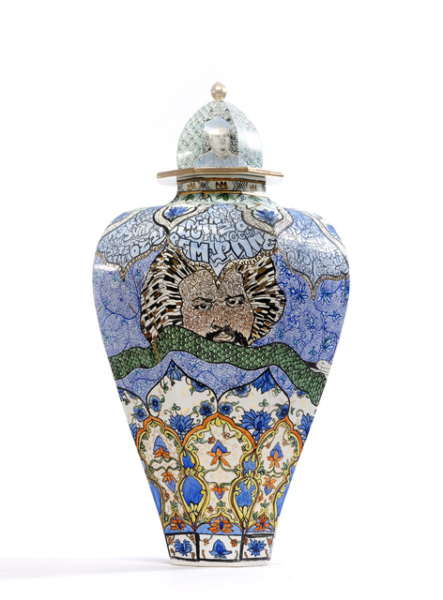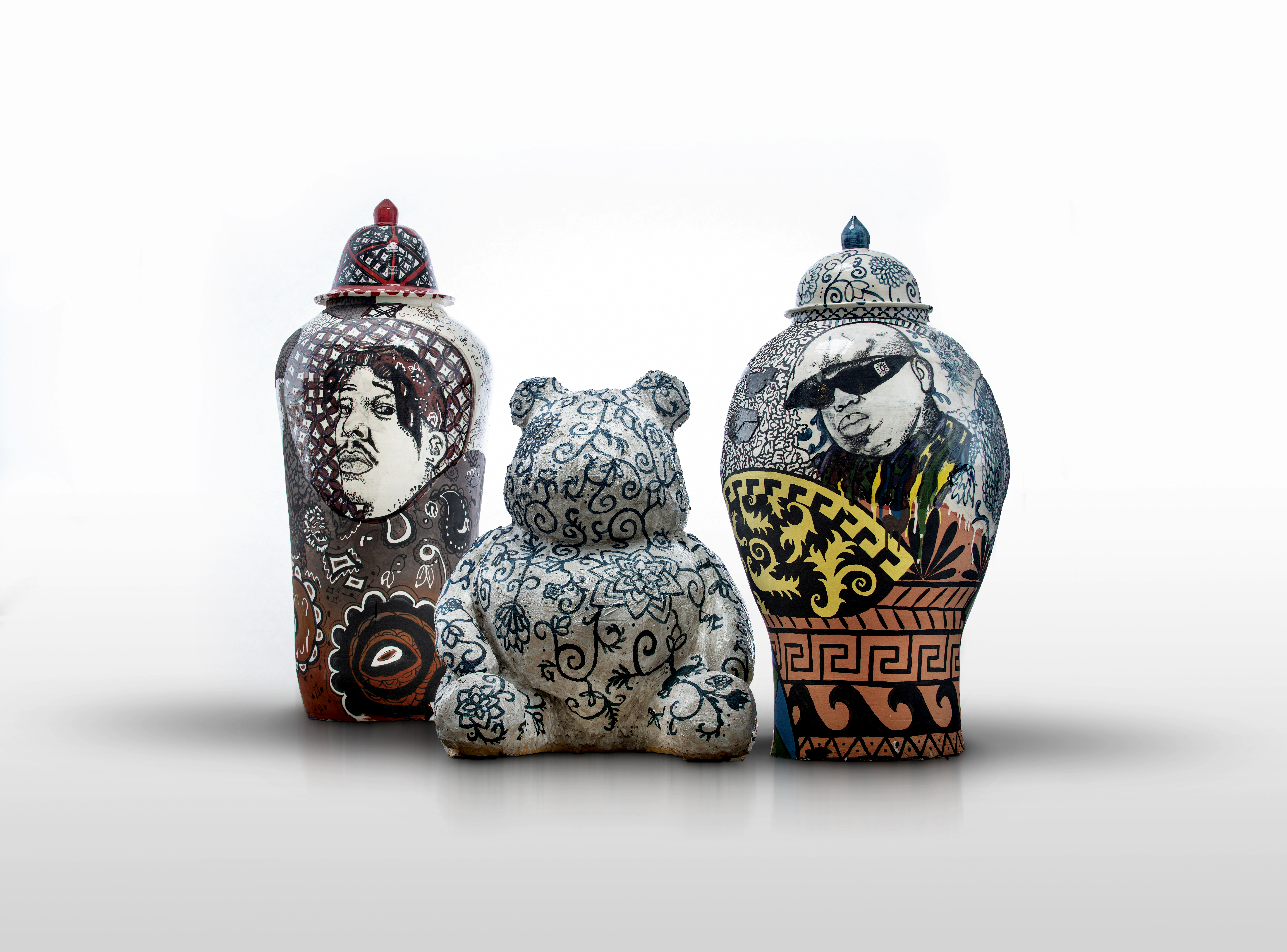Meet Roberto Lugo, the Potter Making Ceramics of Biggie and Basquiat

Ceramicist Roberto Lugo’s visual arts induction began with graffiti—an intentional finger pushing the button on a can of spray paint until color spews from the nozzle, adding both pigment and personal narrative to the otherwise indiscernible surfaces which surrounded him in Philadelphia. That nascence isn’t shocking when you consider Lugo’s work: he calls himself “the ghetto potter,” and the distinction suggests a variation on a status quo, an identity grafted onto an art form that has previously been kept walled itself off from work that originates on the street. The faces of Biggie, Tupac, and Martin Luther King Jr., drawn by Lugo and often in black and white, peer from the classic silhouettes of his urns. They surprise you with their presence there, and then ask you why they do.
When I spoke to Lugo, he was preparing to transplant his life: he is the first ceramicist to win the Rome Prize, and will live in Italy until the summer to work on his new massive project, “Valor in Vandalism: a Revolutionary Triptych,” a recreation of everything in Napoleon’s sprawling (here, “sprawling” means almost 200 pieces) dinner set. The pieces, when finished, will serve their practical functions rather than sitting primly behind glass—Lugo will organize two dinners, one in his native Kensington, Philadelphia and one in Rome, focusing on the inclusion of people to whom the concept of a “dinner set” is alien or ludicrous, as ‘afternoon tea’ was at first to Lugo, like community organizers and recovering victims of addiction. But before his transatlantic journey, Lugo, Seth Rogen‘s new pottery-swapping pal and proud placeholder on Hyperallergic’s “Top 20 Exhibitions of 2018” list, walked us through a selection of his culturally-hybridized vessels.
———
To Disarm: Tupac, 2019
“Tupac is one of the preeminent figures that we think of when we think of gun violence—this barrel as the spout is actually from the gun buyback program in Connecticut. One of the reasons why I started making teapots is because the things I want to say don’t necessarily seem like conversations that would happen in some places. Most of the time when people see me, they don’t say, ‘Oh that guy looks like a potter.’ So I like to play on what people don’t think that I’m capable of. Growing up, we didn’t drink tea at home. The way that a teapot works was a new component to my life. And when I first started taking a ceramic class, all the students were making teapots and I didn’t really understand it. I was thinking to myself, ‘How much tea are people drinking?’ I was surrounded mostly by white people. I thought, ‘This is something that’s not for me culturally,’ like, making pottery felt like it wasn’t something that I was supposed to be doing. When I make a teapot, I’m thinking about the accessibility of that particular vessel. Usually when people sit down and drink tea, it’s more than one person and it happens around a conversation. There’s more implied than just the consumption of tea.
So one of the reasons why I put portraits on these pots is to look at history and re-contextualize the ceramic vessel. That, and really all decorative objects that have been used just for the wealthy. There’s a distinct separation of classes that happened in the history of ceramics —at some point porcelain was considered more than expensive than gold. And so I’m thinking about that wealth gap, I’m thinking about the sort of contrast and livelihood, the violence on the streets that I grew up in versus the people that I wind up surrounding myself with. And their childhoods, where they got to have tea time and have a really different experience … it’s less about pointing the finger and it’s more about figuring out how I can be included in this world where I now find myself.”
———
The Expulsion of Colin Kaepernick and John Brown, 2017

“John Brown’s portrait is a drawing I made based off of that photograph they have of him in the National Portrait Gallery. Someone who works at the museum told me that the most visited photograph, and the one that people seem to be intrigued by, is this photo of John Brown. And I started to think to myself a little bit about where I found myself in it, in the role of an ally. And how these obstacles, overcoming these barriers in racism, is not just a black or brown issue. It’s sort of an everybody issue. This is a person who was fighting against slavery in a time when that’s not what most white people were doing. Slavery was all that they knew. At the time he was a controversial figure; he was somebody whom you either loved or you hated. Now we can look back at him and say, ‘Well, you know the fact that he was anti-slavery is not really a controversial thing. I mean, it’s something that we should all believe in.’
And so my argument and my reason for putting him with Colin Kaepernick is to say that Colin Kaepernick is the same as Brown in many ways: he’s a complicated and controversial figure now, and people love or hate him. But the protests and the things that he’s standing up for are things that I feel like a hundred years from now we might look back at and say, ‘Well, obviously there was an issue with police brutality in the country.’ I’m trying to connect people with the fact that their current perception of Colin is only influenced by the people that they surround themselves with. But if they were to look at why he’s actually doing this and understand that this is a real issue, then he’s not a controversial figure. He’s just a person who’s standing up for what they believe in. It’s not all the time that I have such a deep purpose for the relationship between two figures. Sometimes it’s a matter of me wanting to know what a conversation with Tupac and Malcolm X would look like, or Tupac and Martin Luther King.”

———
Law and Order: The Reincarnation of Frederick Douglass, 2017

“I made this at a time when Donald Trump had just talked about Frederick Douglas as if he were alive in the current. I was thinking to myself that where I grew up, people like Frederick Douglas were our superstars. They’re the people that we grew up reading about, and specifically growing up in Philly, there wasn’t a great education system. But we definitely knew all of our black figures that had come before us and had made such an impact. To know the story of Frederick Douglas so well, and to have someone be the president of United States and not even know who he is…What’s interesting is that a lot of people around the country don’t know who Harriet Tubman is or who Frederick Douglass is. I don’t think I’ve ever met anybody who doesn’t know who Martin Luther King is, but you’d be surprised how many people look at the iconic face of Harriet Tubman and are like, ‘Who’s that?’
I’m kind of nervous about this piece, now on display at the Museum of Fine Arts in Boston. The President is such a polarizing figure. And generally my work is a way of paying homage. It’s never been made to be divisive. But thinking of Frederick Douglass and how I often used his portrait on my work, and then having him come up in the sort of mainstream media through this lens, it felt like… As an artist, sometimes you feel like you can’t not make an artwork.”

———
Same Ol’ Crack, 2019

“I found Basquiat later in life. Growing up and doing tagging, I’d always signed my name with a crown and most of my cousins also signed their names with crowns. And when I was in undergraduate school, someone asked me, ‘Why are you always using Basquiat’s crown?’ I said, ‘That’s not Basquiat’s crown.’ I didn’t really even know who Basquiat was. Obviously this is somebody who I should have known as a child, but we weren’t really exposed to visual arts and artists. You and I are participants today in that. My kids are going to know somebody of that caliber. But it’s not somebody who my parents even know, today, even though his work is so influential on what I do. His graffiti name was Samo, like ‘same ole shit, different day,’ Same-o. So that particular piece has him and Keith Haring on the other side—that’s where the crack component comes in … Like, ‘crack is whack’ sort of thing. The thing that I admire about Basquiat the most is the ability he had to not give a shit about what people thought. I aspire to be that confident of an artist. I think you can see the bravery in his work. It sounds corny because it’s not ultra political right off the bat, but he paints and draws in this way, like he knows exactly where this particular word is supposed to go, and that’s the only place where that ‘X’ could be. So he’s definitely a really inspirational figure.”

———
Street Shrine 1: A Notorious Story, 2019

“These street shrines came about when I moved back to Philadelphia, and I remembered how people would pay homage to people in Philly when they died in the streets from gun violence: there’s all these pop up shrines in Philly or teddy bears and pictures of the person who passed away and letters to that person. And they’re all done in the street—they’re ephemeral. One of the things that I think is so compelling about clays is that for the last thousands of years, it’s been used to tell stories through anthropology. So I thought about how I would memorialize and give permanence to this object that’s ephemeral, this teddy bear that’s sort of like put it out in the street. I wanted to be able to make that connection between the ceramic urns and the sort of shrine that happens in the street and put them together as a collective to be a representation of my culture within this grander landscape of historically commemorated death or homage.”
———
To Disarm: MLK Mugshot, 2019

“This piece is a reminder of this icon and what he stood for, and the goodness that he stood for, and the life that was taken. I mean, he was shot for similar things that we’re talking about today. At the end of the day he was shot over political differences—people being afraid of change and people being afraid of black people having equal power. It’s really a humanitarian issue. If we look at how people today talk about racial issues, and other topical issues today, I would say that these people that murdered Martin Luther King, and that type of person, are still around. But they’re much more passive aggressive about the way that they do things. And maybe they don’t overtly use the n-word, but we’re still struggling with a lot of the same issues. One of my hopes with this particular pot is to remind people of his face and to remind them that it was taken away from us. And to be reminded of what led up to his life being taken away from us, which is, I think, the biggest lesson that we can learn. When I had this piece in Chicago, interestingly enough, Jesse Jackson was visiting the expo center and got to see it. It was a really amazing moment to have Jesse Jackson look at my work and especially, with all his connections to Martin Luther King, to be able to see that. “






